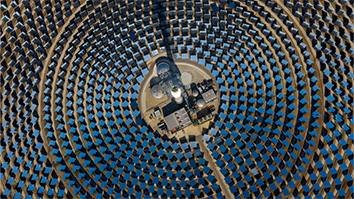Note: Guest blogger Rob Day is a partner with Black Coral Capital. He is conference chair for Greentech Media NextWave Investing 2014, to be hosted by SRI International in Menlo Park, CA on August 5. This blog post originally appeared on greentechmedia.com .

Someone reached out to me the other day to ask about greentech startups, and during the discussion mentioned having heard that it typically takes at least $100 million to successfully develop and commercialize a green technology.
I replied that I knew of plenty of startups in our sector that have gotten to significant revenue on far less than that. The response: “Oh, I was talking about hardware-based greentech.”
I responded that I was talking about hardware-based greentech startups, too. That killed the conversation.
As we start to really differentiate between “last-wave” and next-wave greentech, it seems that there’s a basic disconnect when it comes to how people talk about “hardware” startups.
People I speak with outside our industry often reflexively think of greentech as being capital-intensive, because to them the only “real” greentech plays involve a fab or a production plant or a specialized manufacturing plant. When I point out that many greentech startups nowadays are software- or web- or service-based, they kind of nod politely and go back to talking about major pieces of capital equipment.
And that makes sense—if your frame of reference is the last wave of greentech investing, because that’s exactly where a large portion of the capital and a majority of the hype went. I went back and estimated how much capital was required for certain famous greentech examples simply to get to commercialization and replicable revenue. (These estimates are based mostly on what’s available via the web and S-1s, so calculations aren’t exact.)
- Solyndra: $375 million
- MiaSolé: $335 million
- Bloom: $450 million
- Tesla: $105 million
- KiOR: $275 million
In an era when entrepreneurs and venture capitalists are looking for business opportunities that are quick to market and can scale rapidly, you can see why anyone with this framing of our sector would be running for the hills. If the above list of startups represents your idea of what “greentech” looks like, you can find the occasional winner (Tesla), but not a consistent path to returns. And there’s certainly a heck of a lot of risk along the way.
That’s why next-wave greentech is about opportunities where the entrepreneurs can quickly get to market and start generating revenue with significantly less capital than the above last wave plays. Here are a few examples of greentech startups that have become successful exits or at least gotten to tens of millions of dollars in revenue, and how much capital was required for them to get to successful commercialization:
- Opower: ~$15 million
- SolarCity: ~$10 million
- Zep Solar: ~$10 million
- ecoATM:
- Digital Lumens: $11 million
- Next Step Living: $2 million
- And of course Nest, which keeps the size of its Series A and B a secret, but launched product less than two years after founding.
Many of these companies eventually raised more capital than what’s shown above. But it was raised to fund growth, with solutions for which the market had already demonstrated some acceptance.
You can’t make reliable returns as an entrepreneur or an investor if it’s going to take hundreds of millions of dollars and several years of development before you know if you’ve even got a solution that the market is willing to pay for. And right now in particular, the investment community isn’t interested in funding those types of moon shots.
Which brings me back to hardware. Yes, some of the companies on that second list are predominantly software- and/or service-based, but there are a few hardware companies on that list as well. “Hardware” is simply any physical product. It can be a huge, honking piece of expensive machinery, or it can be a small consumer product, or anything in between. You can’t really lump them all together like some people want to, nor can you talk about “greentech hardware” and only mean the big, expensive kind.
My point is that you shouldn’t exclude hardware from the “next wave” concept just because some hardware is necessarily expensive and slow to commercialize. Capital-efficient, scalable greentech is not just about software and web plays. Not at all.
So yes, next-wave entrepreneurs are tackling — and in many cases, succeeding — with hardware solutions. But how?
We can start to talk about some lessons learned already from early successes. Not every single one of these lessons is applicable to every greentech hardware startup, of course, but the more that entrepreneurs are able to hew to these success factors, the easier their pathway to winning.
1. Design for contract manufacturing
Building a factory is expensive. So unless you’re intent on achieving an extraordinary level of quality control or you’re building something that simply cannot be contract-manufactured, you don’t want to build a factory as a startup.
Your first few sold products may need to be handmade and hand-assembled, but to scale up, many successful hardware entrepreneurs find they need to design for contract manufacturing right from the start. Cyril Ebersweiler and Benjamin Joffe have some good thoughts in this respect. But I think about these things in terms of team: Make sure someone on your technical team is competent at dealing with contract manufacturing and knowing how to design with it in mind.
2. Small and distributed are beautiful
It’s no coincidence that the fastest-growing markets in greentech are being driven by distributed assets like rooftop PV, LED lighting, and such. It’s because that’s where new technologies and products can most readily scale.
First of all, it’s easier to build such devices, in most cases, for obvious cost and complexity reasons.
Second, they tend to compete with edge-of-network costs, which are most often higher than those found in centralized incumbent systems. With electricity, for instance, it’s easier to compete with retail electricity costs at the consumer end than wholesale power costs.
Third, distributed assets are able to more readily apply to niche, accessible applications where they’re a good fit even during their early, higher-cost stages. This is why, for example, Digital Lumens went after refrigerated warehouses (where the economics were a no-brainer and the customers were relatively accessible) as its initial proof to customers. With that foothold established, the firm was then able to expand across the whole industrial lighting market.
Fourth, to the extent that smaller and distributed assets are going after a more numerous customer set, that can increase the odds of finding a critical mass of early adopters willing to try out the technology, even if it doesn’t yet make sense economically for the larger set of customers.
So we see smaller, simpler devices able to get a foothold in the market, using that foothold to establish reputation and get early revenue and market feedback, and then competing against other high-cost or even nonexistent options in order to scale up as their own costs go down. This doesn’t work for large, centralized production technologies, which really cannot compete in the market until they have already driven down costs.
3. Scale up capacity via modular design
Just because the assets and devices are small doesn’t mean they can’t add up to big capacity systems. Several industrial technology startups such as newterra are building standardized and modular systems that can be combined into larger-capacity systems when needed. This provides maximum flexibility for addressing a wider range of applications, which makes both manufacturing and selling easier.
4. Leverage intelligence
Distributed, modular devices are only truly enabled by intelligence. Automation and coordinated data allow for the hardware to be much cheaper, because the intelligence enables a wider array of capabilities and applications using simpler devices. Plus, they enable services revenues beyond just upfront equipment sales. People rightfully credit the product design of the Nest thermostat, but it’s the connected intelligence of the devices that really drove adoption (that, and very successful marketing, of course).
Embedded intelligence also allows you to sell hardware that is inexpensive to make because it has few if any proprietary components, and yet has significant proprietary IP in the controls built in to the overall solution. Plus, the data gathered from networked devices in the field can be valuable in its own right.
5. Test your application with the market before you build a product
You are not really selling hardware. You are selling a device that provides the service. To the extent that it is practicable, test that service with customers before expensively developing a proprietary piece of hardware. I’ve met with entrepreneurs who have built their initial commercial systems with off-the-shelf parts, even while still developing their proprietary solutions to integrate into future offerings. OsComp is one such example.
But at the very least, go verbally test your service before you spend a lot of time and money developing a proprietary technology. To be fair, you shouldn’t expect that customers will know what they want before they actually have something to interact with, so don’t just go asking open-ended questions in hopes that customers will write your product specs for you. But make sure you’re not developing a technology in search of a problem — that almost never works.
6. Prototype cheaply, and get feedback quickly
Hardware entrepreneurs now have access to rapid prototyping options they never had before. 3-D printers are a wonderful way to mock up prototypes that customers can play around with, using off-the-shelf components inside in some cases. These and other expensive pieces of equipment are now accessible at various prototyping incubators and labs that can be found in many entrepreneurial regions. For instance, here in Boston, we have Greentown Labs and Bolt, just to name two examples. Both have lots of equipment for entrepreneurs who want to develop their first prototypes and be able to go interact with customers.
Getting that early feedback is important for testing your application. And it’s OK if the first feedback is negative. Fail quickly, and learn from the feedback how to design the next product so that you’re eventually giving customers something they really want.
7. Sell directly before you go to channel partners
Many a great device has languished because channel partners were slow to sign up to sell it, and then were not good at selling it. You’re developing something new to the market, with new capabilities. Most channel players (distributors, system integrators, reps) are only used to selling existing products.
The logic of selling through channels is compelling for a startup. You don’t have a big sales force and you don’t have the credibility that a channel partner does with its existing customers. It seems like the fastest route to scaling up revenues. But again and again, I’ve seen startups that attempt that route fail, at least if they’re doing it as their first go-to-market strategy.
Lights are a great example. LED lighting is introducing a brand-new, bundled product to the marketplace. LED fixtures are an upfront sale with a total-cost-of-ownership (TCO) advantage over incumbent technologies; they don’t require changing bulbs and they run more efficiently. Yet they often have a higher upfront cost. And they can offer additional capabilities, such as embedded intelligence, that traditional fixtures can’t even begin to offer, making them new to everyone. Existing channels weren’t prepared to sell them until relatively recently.
Selling directly to customers allows you to make the business case directly. It allows you to get instant feedback. It allows you to learn how to sell the hardware, and learn what ancillary services the customers will need to make the economics work. All of this not only helps you get early traction and design your next product iteration for maximum customer acceptance, but it also eventually helps you select and enlist the right channel partners for when you have a product that is truly ready to scale.
8. Offer customers no-money-down solutions
Some hardware simply isn’t that expensive. But many hardware solutions are expensive enough that the upfront cost can be an adoption hurdle, even if the TCO pencils out on paper. Customers may have cash challenges, or they may simply not believe the claimed paybacks. So for many hardware entrepreneurs, customer financing ends up being an important option to offer.
For B2B solutions, there are emerging offerings like those from Noesis Energy that can help provide this, or there are any number of equipment leasing vendors. Some startups end up self-financing some of these solutions (although that requires some good capital resources), selling via a capital lease, or even using a form of hardware-as-a-service. You may not be able to get third-party financing for your first few installations, but it’s worth working toward underwritability from the beginning, with financing as a long-term goal.
Hardware and software/web winners are actually similar in that they typically got into the market quickly and inexpensively. Hardware isn’t inherently a poor fit for the greentech next wave. In fact, entrepreneurs applying these lessons are already found in just about every subsector of greentech — even if people outside our market don’t know to look for them.



